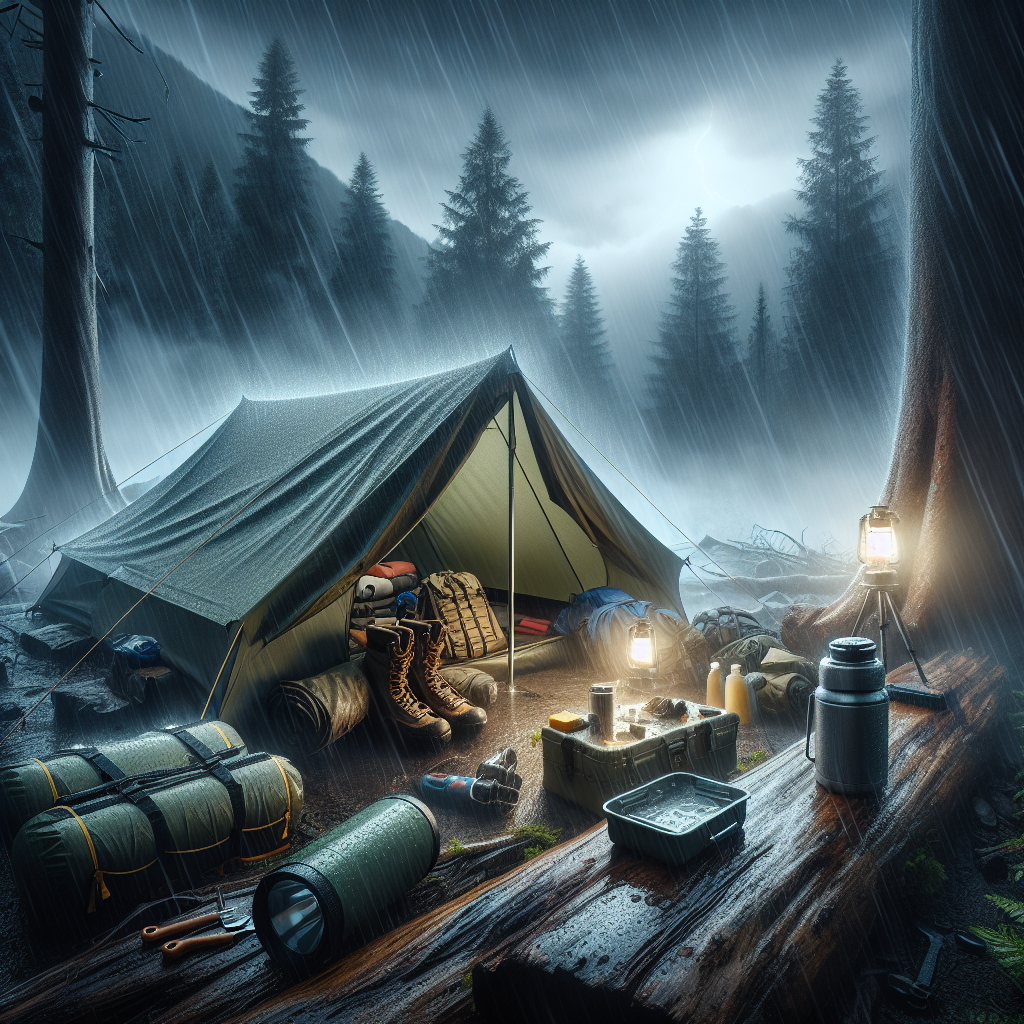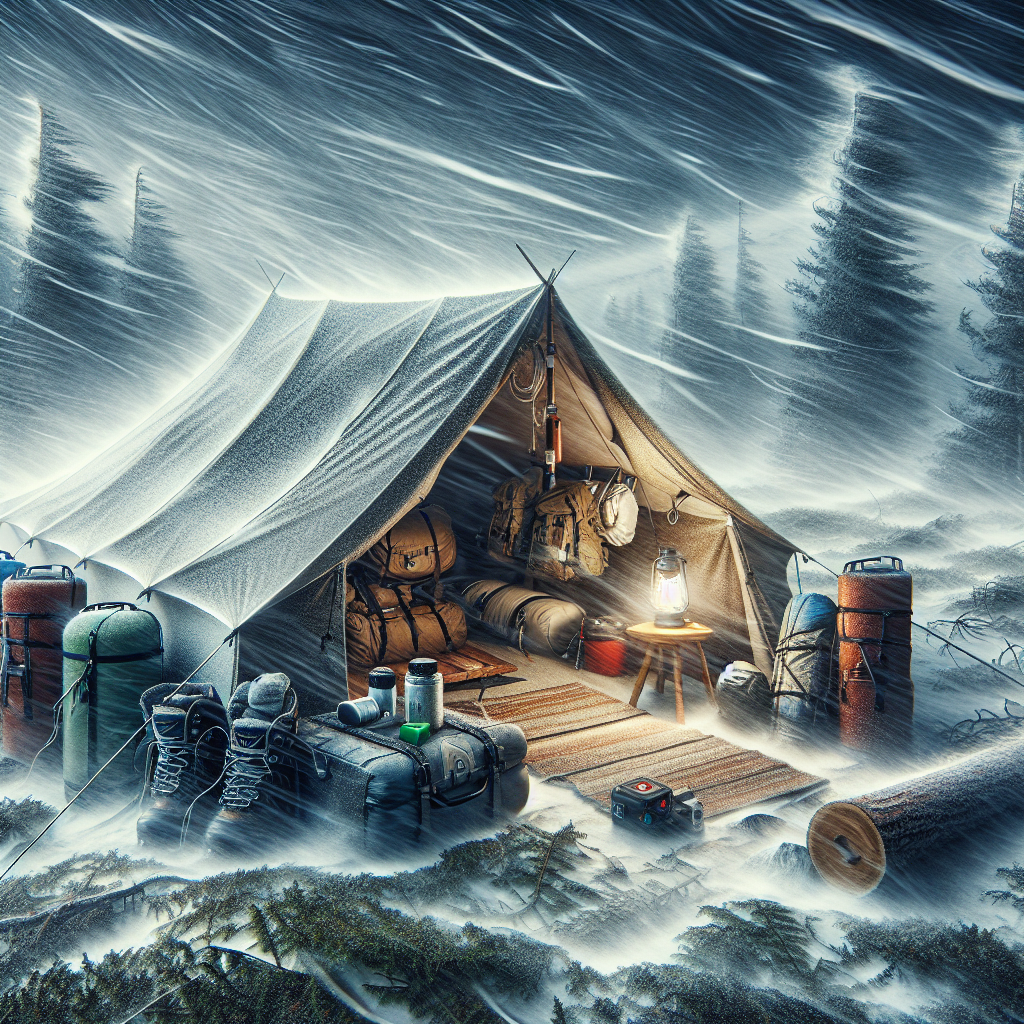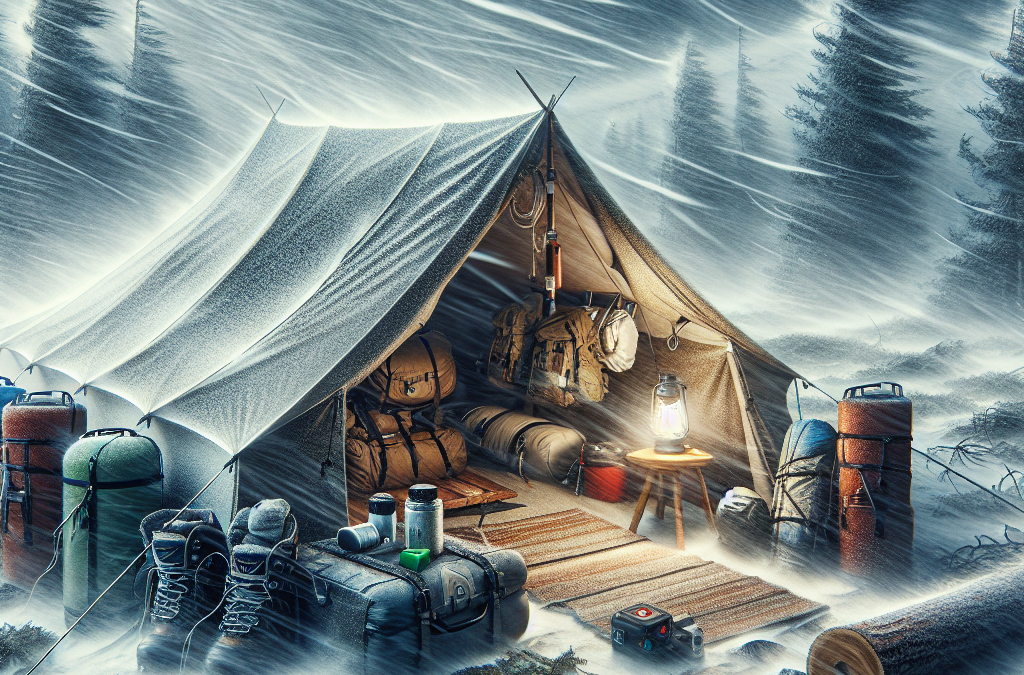Embarking on a camping trip can be a thrilling adventure that unravels nature’s unmatched beauty at your fingertips. However, an unexpected turn in weather conditions can flip the script frighteningly fast, presenting new challenges and risks. “Dealing With Extreme Weather: Camping Safely” is here to help you navigate these unpredictable terrains with confidence. This guide offers safety tips and survival tactics geared towards preparing you for treacherous weather shifts while camping. Bracing for the worst while hoping for the best can make your outdoor exploits unforgettable, for all the right reasons. So, gear up and fear not; this comprehensive article has got your back!
Understanding Different Extreme Weather Conditions
Extreme weather conditions can vary greatly, ranging from intense heat to biting cold, from torrential rain to mighty wind gusts, and even blizzard or wildfire conditions. Learning about these weather conditions, their effects on the camping environment, and how to monitor weather changes are essential in preparing you for a safe and enjoyable camping experience.
Types of extreme weather
The key types of extreme weather that you should be aware of include heat waves, cold snaps, heavy rain, flooding, snow, blizzards, thunderstorms, lightning, high winds, and wildfires. Each type of weather presents unique challenges and requires different strategies for camping safely.
Effects on camping environment
Each type of extreme weather can drastically alter the camping environment. Heat waves can dry out vegetation and make it more susceptible to fire. Cold snaps can freeze water sources and make travel difficult. Heavy rain and flooding can turn a dry campsite into a swamp. Snow can limit visibility and mobility. Thunderstorms and lightning can create hazards with falling trees and fires. High winds can topple tents and other structures. Wildfires can spread rapidly and unpredictably.
How to monitor weather changes
Monitoring weather changes is key to staying safe while camping. Use weather apps on your phone, listen to weather forecasts on the radio, or check online weather sites regularly. Be alert for changes in wind direction and speed, temperature, humidity, and cloud formations, all of which can be signs of oncoming extreme weather.
Preparing for Extreme Heat
Extreme heat can pose serious health risks, but with the right preparation, you can safely enjoy your camping experience.
Understanding heat-related illnesses
Heat-related illnesses, such as heat stroke and heat exhaustion, can be life-threatening. It’s crucial to understand the symptoms – such as confusion, rapid pulse, lightheadedness, nausea, and excessive sweating – and take immediate action by seeking shade, hydrating, and rest.
Choosing appropriate camping gear
When camping in extreme heat, choose light-colored, loose-fitting clothing that helps reflect the sun’s rays and promotes evaporation of sweat. Select a tent with good ventilation to enable air circulation.
Staying hydrated
Bring plenty of water and drink regularly, even if you don’t feel thirsty. Avoid alcohol and drinks high in sugar, as they can lead to dehydration.
Finding shade and cool environments
Regularly seek shade under trees or other structures to escape the direct sun. Take advantage of natural water sources, but beware of currents and depths.
Adapting activities to lower temperature times of day
Plan your strenuous activities for the cooler parts of the day—early morning, late afternoon, or evening. Rest and hydrate during the hottest part of the day.

Surviving Extreme Cold
Extreme cold comes with its own set of challenges, but with the right knowledge, resources, and planning, the cold weather doesn’t have to ruin your camping trip.
Understanding hypothermia
If your body loses heat faster than it can produce heat, you are at risk of hypothermia, a life-threatening condition. Symptoms include confusion, sluggishness, memory loss, slurred speech, and decreased alertness.
Importance of layered clothing
Layering your clothing traps heat and allows you to adjust to changing conditions. Consider three layers: a base, middle, and outer layer to manage sweat, insulate, and protect against wind and rain, respectively.
Selecting a winter-suitable campsite
A great winter campsite is in an area protected from wind and hazards such as falling branches. Avoid areas near water that might be prone to flash floods.
Keeping warm while sleeping
Use insulated sleeping pads, bags rated for the lowest possible temperature you might encounter, and wear thermal underwear and socks. Eat high-energy food before bed to help your body generate heat.
Meal planning for cold weather
Your body burns more calories in cold weather, so plan meals high in protein and complex carbohydrates. Soup and hot drinks can also help you stay warm.
Dealing with Heavy Rain and Flooding
Rain during a camping trip can be more than just an inconvenience. In extreme cases, it can lead to a very dangerous situation. However, with the right planning and precautions, you can weather the storm.
Selecting a flood-safe campsite
If rain is predicted, avoid camping near rivers, lakes, or in valleys where there is a risk of flooding. Choose higher, well-drained ground instead.
Setting up a waterproof tent
A waterproof tent with a full-length rainfly is crucial. Ensure the tent is fully sealed and that you have a tarp for additional protection if necessary.
Protecting supplies from water damage
Place supplies in waterproof bags or containers and store them off the ground. This includes food, clothing, first aid supplies, and important documents.
Recognizing flood danger signs
Floods can occur quickly and without much warning. Signs to look out for include sudden changes in water levels or water color, increased water speed, and sounds of trees or debris being carried downstream.

Facing Snow and Blizzard Conditions
Camping in snow can be a magical experience, but extreme conditions like blizzards require special preparation.
Packing the right gear
Pack gear designed to withstand the cold, wind, and snow. This includes a sturdy tent, sleeping bag rated for cold weather, snowshoes, and insulating layers.
Building a snow shelter
Knowing how to build a snow cave or other type of snow shelter can save your life in a blizzard. Be sure to mark your shelter so rescuers can find you if necessary.
Staying warm and dry
Wet clothes can quickly drain your body heat and put you at risk for hypothermia. Always keep a dry set of clothes available.
Navigating in snow
Navigating in snow can be challenging due to limited visibility and changes to the landscape. Use a compass, make your own trail markers, and avoid areas of potential avalanche.
Handling Thunderstorms and Lightning
Thunderstorms and lightning can be particularly dangerous while camping. Understanding how to navigate these situations can keep your camping trip safe and enjoyable.
Recognizing signs of an approaching storm
Signs of an oncoming thunderstorm include dark, towering clouds, a sudden drop in temperature, gusty winds, and distant thunder or lightening.
Lightning safety tips
Lightning tends to strike at the tallest objects. It’s best to avoid open fields, tall trees, and bodies of water. If in the forest, find a low area under small, thick trees. Stay low to the ground, but not flat which can increase risk.
What to do if you’re caught in a thunderstorm while camping
If a thunderstorm catches you while camping, seek shelter in your vehicle if possible. If that isn’t an option, make yourself safe and less of a target for lightning strikes. Stay put until the storm has passed.
Managing Windy Conditions
Strong winds can pose challenges for campers, overturning tents and creating dangerous situations with falling branches. However, with a bit of planning, windy situations can be managed effectively.
Choosing a safe location
Pick a sheltered location for your camp, preferably among trees that can act as a windbreak. Avoid trees with loose or dead branches that could fall on your tent.
Securing your gear
Reinforce your tent with extra stakes and guylines. Secure loose items and put away anything that could be blown away or turned into a projectile by strong winds.
Preparing for sudden weather changes
Strong winds can be a precursor to some forms of extreme weather like thunderstorms, blizzards, or even tornadoes. Monitor weather forecasts closely and prepare for possible weather changes.
Wildfire Safety Tips
Wildfires are a serious danger, especially during dry periods. Awareness and precautionary measures can greatly reduce the risk of a disastrous situation.
Understanding fire weather
Fire weather consists of high temperatures, low humidity, and wind—these are the conditions under which wildfires are likely to occur and spread. Monitor the weather and avoid building fires under fire weather conditions.
Campfire safety
Ensure you follow all campfire safety guidelines: keep fires small, never leave them unattended, and fully extinguish them before leaving or sleeping. Keep fires away from vegetation and flammable materials.
Evacuation planning
Always have a plan for fast evacuation in case a wildfire approaches. Know your escape routes, gather your essentials quickly, and leave as soon as the order is given.
Monitoring wildfire information while camping
Most regions prone to wildfire have systems in place for notifying residents and visitors. This can include sirens, public address systems, or alerts sent to mobile devices. Stay informed and heed all advice or orders.
Developing a Comprehensive Emergency Plan
Because weather can change rapidly, a thorough emergency plan is a vital part of camping safety.
Establishing communication strategies
Ensure you have a reliable means of receiving weather updates and contacting emergency services. This could include a cell phone, two-way radios, or satellite phones.
Planning escape routes
Know the quickest, safest way out of your campsite and the surrounding area in case of a sudden emergency. If possible, identify multiple routes.
Preparing a survival kit
Your kit should include basics for survival: water, food, first aid supplies, tools like knives and cordage, blankets, flashlights, and batteries.
Educating all members of camping party
Everyone in your camping party should understand the emergency plan and know what to do in different situations. This includes kids, who should have a simple, easy-to-remember plan.
Safety Tips for Recreational Activities During Extreme Weather
Even when dealing with extreme weather, you can still enjoy outdoor activities, as long as safety guidelines are followed.
Water-based activities
Always wear a life vest when participating in water-based activities. Monitor weather conditions closely and stay close to shore. In fast-flowing rivers, watch out for flash flooding.
Hiking
For hiking in extreme heat or cold, dress appropriately, carry ample water and snacks, and stick to well-defined trails. In heavy rain, snow or windy conditions, consider postponing your hike to avoid getting lost or injured.
Climbing
Extreme weather can make climbing dangerous. High winds, rain, or a sudden drop in temperature can create treacherous conditions. Always check the weather forecast beforehand and never climb alone.
Wildlife encounters in extreme weather
Extreme weather can sometimes bring out unusual wildlife behavior. In times of drought, for instance, animals may approach campsites in search of water. Always keep a safe distance, and secure your food and garbage to avoid attracting animals.

